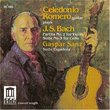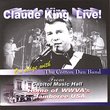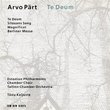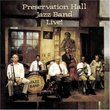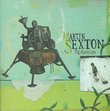| All Artists: Clara Rockmore Title: The Art Of The Theremin Members Wishing: 4 Total Copies: 0 Label: Delos Records Original Release Date: 12/14/1992 Release Date: 12/14/1992 Genres: Special Interest, Pop, Classical Styles: Vocal Pop, Ballets & Dances, Ballets, Waltzes, Chamber Music, Forms & Genres, Concertos, Historical Periods, Classical (c.1770-1830), Modern, 20th, & 21st Century, Instruments, Strings Number of Discs: 1 SwapaCD Credits: 1 UPC: 013491101422 |
Search - Clara Rockmore :: The Art Of The Theremin
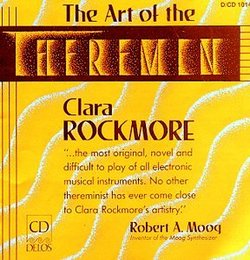 | Clara Rockmore The Art Of The Theremin Genres: Special Interest, Pop, Classical
In 1927, two remarkable people arrived in the United States after lengthy and successful tours of Europe: Lev Sergeivitch Termen (anglicized to Leon Theremin) and Clara Rockmore (whose maiden name was Clara Reisenberg). Th... more » |
Larger Image |
CD DetailsSynopsis
Album Description In 1927, two remarkable people arrived in the United States after lengthy and successful tours of Europe: Lev Sergeivitch Termen (anglicized to Leon Theremin) and Clara Rockmore (whose maiden name was Clara Reisenberg). Theremin was a young Russian physicist who was demonstrating a new musical instrument that he invented. The instrument was played by the motion of the musician's hands in the space surrounding the instrument. Clara Rockmore, a professional violinist from the age of 9, became aware of the musical potential of Theremin's invention. She spent several years collaborating with Theremin during which time he developed his invention into a sensitive, wide-range musical instrument. Clara subsequently embarked on a performance career that encompassed well over a hundred concerts, including appearances with major symphony orchestras, and set the definitive standard for theremin performance technique.To play the theremin, the performer stands in front of the instrument, a little left of center. The feet are spread slightly to keep the body as motionless as possible. To determine the pitch of the instrument's tone, the player varies the distance between her right hand and the pitch antenna. When the instrument is properly tuned, the pitch goes from lower than two octaves below middle C when the player's right hand is back at her shoulder, to approximately 2 1/2 octaves above middle C when the player's hand barely touches the pitch antenna. To determine the loudness of the instrument's tone, the player varies the distance between her left hand and the middle of the volume antenna. Maximum loudness occurs when the hand is removed from the antenna; complete silence occurs when the hand is an inch or so from the loop. The thereminist must move her hands with incredible precision as well as speed if she wishes to play distinct notes with correct intonation. Ms. Rockmore actually uses fingering patterns to play the most rapid passages. For instance, if she were to play an upward arpeggio, she would start on the lowest note with right hand tilted back and fingers withdrawn. To play the next note she would abruptly move her hand forward from the wrist, while keeping her right arm motionless. The third note would be played by rapidly extending the little finger, and the fourth note by extending one or two more fingers while simultaneously turning the wrist sideways to bring the newly-extended fingers nearer to the pitch antenna. She would then continue the arpeggio by moving her whole arm closer to the pitch antenna while drawing her hand and fingers back, then repeating the above-described succession of movements. At the same time, she may articulate each individual pitch by rapidly shooting the fingers of her left hand into the volume antenna loop, then withdrawing them, to silence the tone during the very short periods of time that her right hand moves from one pitch to another. No other theremin player has ever mastered this difficult and intricate technique for playing rapid successions of precise pitches - "aerial fingering" as one reviewer termed it. Similar CDs
Similarly Requested CDs
|
Member CD ReviewsReviewed on 6/12/2008... The theremin is a very unique instrument, producing eerie sounds, almost like the human voice. It was used effectively in the movie Spelllbound as well as other movies. It is especially effective in these classical selections and highly recommended.
CD ReviewsClara Rockmore and the Theramin Nancy Moran | Baltimore, Maryland USA | 10/30/2002 (5 out of 5 stars) "Imagine a virtuoso soprano with an unlimited upper range. Imagine a violin with the lower range of a cello. Imagine an instrument that allows for every nuance, for every slight embellishment, for every dynamic flourishment imaginiable.This album consists of plain piano and plain theramin - no other orchestration.The Theramin, as proved by Clara Rockmore, is capable of soaring song, of delicate melody, of pure expression.Rockmore's performance is a pure joy and a testament to the versatility of the instrument. When she takes off in the higher registers, the only thing missing is diction. But she more than amply supplies it with her exploration of all the registers this instrument is capable of - she is also capable of exploring the theramin as a contralto.This is an extraordinary album and well worth the price paid. Were it not for synthesizers and whatnot, the theramin would be envied as an instrument for virtuoso musicians." Superb Theremin Recording Robert Badger | Philadelphia, PA | 05/16/2002 (5 out of 5 stars) "Clara Rockmore was, up until her death in 1998, the foremost theremin virtuosa living at that time. She was introduced to the theremin by its inventior, Leon Theremin (Russian: Lev Sergeyevich Termen). As a violinst, she recognised the great potential of the instrument. Setting the violin aside, she created an entire technique and approach to the instrument that was wholly unique. She showed that it was truly possible for it to be something other than a sound effect machine for Hollywood. By performing the classical repertoire upon it, she showed what was truly possible with this magical instrument.It is by far the most difficult instrument to play. The thereminist has absolutely no tactile references whatsoever. Absolutely perfect pitch is required. The sounds are created by moving one's hands nearer to or farther from the antennae, one to control pitch and the other to control volume and timbre. When one realised the difficulties of this instrument, her performance is made all the more remarkable. She shares with us her great artistry. It is a pity that not more recordings were made of her. Nevertheless, this recording is absolutely wonderful and to anyone who is interested in hearing classical music from a new vantage point, I would reccommend this recording without reserve."
|

 Track Listings (12) - Disc #1
Track Listings (12) - Disc #1
